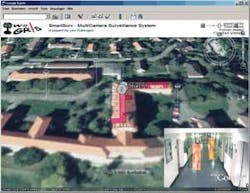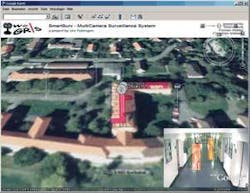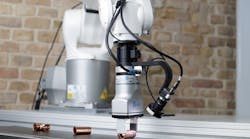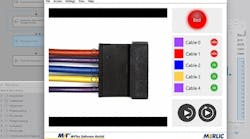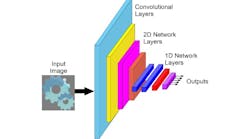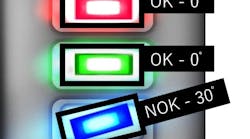Surveillance system tracks/visualizes
In most current surveillance systems, the raw live video stream from a large number of cameras is displayed on a set of monitors, and security personnel respond to situations as they see them. Activity of interest must be manually tracked, and when an individual leaves one camera’s view observers must switch cameras and viewpoints. To improve upon this approach, Sven Fleck and his colleagues at the University of Tübingen (Tübingen, Germany; www.gris.uni-tuebingen.de) have developed what they say is an intuitive visualization approach in which the results of a surveillance system-the person’s path-are reflected in one consistent and georeferenced 3-D world model that is ubiquitously accessible.
On display at VISION 2006 in Stuttgart, Germany, the SmartSurv surveillance system is composed of a distributed network of mvBlueCougar intelligent cameras from Matrix Vision (Oppenweiler, Germany; wwww.matrix-vision.de) that are capable of tracking objects in real time. The visualization capability is provided by a mobile platform containing a laser scanner and panoramic camera or within Google Earth. As the entire tracking is embedded inside each smart camera node, only limited bandwidth is necessary, which makes the use of Ethernet possible. The potential number of cameras could reach into the thousands. Fleck says the group is looking at many applications for which the system could be commercialized, including tracking shopping patterns and monitoring the elderly.
Machine vision reads electricity meters
The Shanghai Power Corporation (Shanghai, China) has undertaken a 5-10-year program to replace old kilowatt/hour meters with more accurate models, but to do so the utility must record and store the final readings from hundreds of thousands of the old meters. In 2005, the utility contracted with system-integrator Microview Science & Technologies (Beijing, China; www.microview.com.cn) to develop a vision system that images the old meters after they have been packed in cartons. “One of the essential requirements,” says Yu Zhao, applications engineer at Microview, “was to capture images of the meters and read the data simultaneously-both the barcode and the numeric characters-and store the results in a database.”
The cartons are moved by conveyor to one of three workstations, where an operator shunts the camera into position using a three-axis manipulator. Microview’s vision system uses an IBM Server X346, three Dell 5150n workstation computers, three Iris P1200 smart cameras from Matrox Imaging (Dorval, QC, Canada; www.matrox.com/imaging) fitted with a CCTV 12-mm lens, and three OEM light sources. Image analysis is performed by the Code Reader and String Reader modules from the Matrox Imaging Library. The barcode and numeric digits that determine electricity usage are processed and compared with old data and stored in a database. When the procedure is complete for all the meters in a carton, the carton is moved to the end of the line where the meters are sorted-some are destroyed and others are sent to smaller cities to be re-used.
